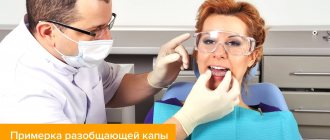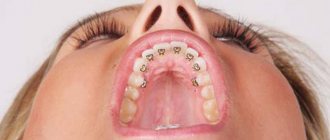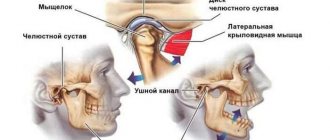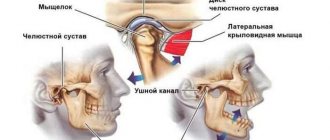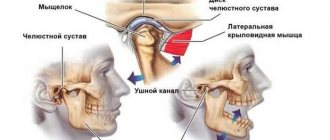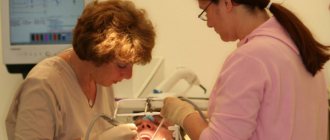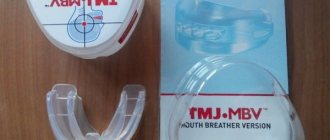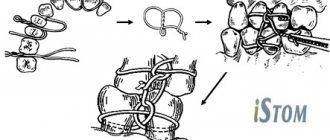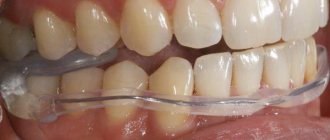Negative symptoms associated with abnormal development of the jaw region do not always manifest themselves in the form of problems with teeth or gums. Pathologies of the temporomandibular joint caused by malocclusion often provoke headaches, extraneous auditory noise, and even deterioration in visual function. The methods used for treatment depend on the indications of the clinical picture. One of the means of treating TMJ dysfunction, recommended by specialists in neuromuscular dentistry, is an occlusal splint, the installation and wearing of which helps restore the natural anatomical structure.
General overview
Technically, an occlusal splint for teeth falls into the category of removable temporary structures. The devices are used as part of the preliminary stage preceding orthodontic or periodontal treatment, as well as the installation of replacement prosthetic structures. The functional task of elastic mouthguards made of hypoallergenic material is to correct the occlusal contact of the elements of the upper and lower row. The device reduces the load on the muscle department, the overstrain of which provokes negative symptoms.
Bytes, aligners, orthotics and splints - what's the difference?
Along with occlusal aligners for children and adults, functional dentistry also uses other designs to solve TMJ problems. They differ in purposes and stages at which they are applied.
An orthotic helps to correct the position of the jaws, restore the normal physiological state and full functioning of the TMJ. The design can be removable or non-removable; it is made of medical plastic and is placed on the lower jaw.
Bytes are devices used to identify and correct displacement of the articular head. They are special “snacks” for teeth that the patient wears for some time.
Splints are removable devices for the lower or upper jaw. Allows you to change the occlusal contacts of the teeth and achieve a functional position of the lower jaw.
Indications
The list of pathological conditions, the diagnosis of which serves as the basis for choosing in favor of the treatment method under consideration, includes:
- Bruxism is uncontrolled clenching of the jaws during sleep;
- TMJ dysfunction;
- Partial edentia requiring installation of dentures;
- Problems with the muscles and joints of the jaw;
- Incorrect development of bite.
A preliminary examination performed in a clinical setting helps identify abnormal findings that require medical intervention.
Recommendations for treatment with occlusal aligners
For treatment to be effective, the following conditions must be met:
- the design must fit the teeth;
- occlusal contacts - correspond to the central ratio;
- There should be no intra-articular structural lesion.
TMJ problems, custom-made occlusal guards are worn until the pain is eliminated and the TMJ occlusion, joint structure, and bite are stabilized. Throughout the entire treatment period, the structures are used mainly at night.
Preparation
Before starting the production of occlusal splints, doctors prescribe a set of diagnostic procedures. Mandatory measures include a general visual assessment of the oral cavity, radiographic examination, computed tomography or MRI. The data obtained characterize the degree of development of existing pathologies, the likelihood of their negative impact on adjacent areas and the patient’s well-being, and also make it possible to draw up a correct treatment plan.
Manufacturing
To create correctors, soft and flexible polymers are used, the shape of which is given on the basis of individual casts and impressions. Basic prototypes take into account the peculiarities of the anatomical structure, thanks to which the doctor has the opportunity to select the optimal rigidity of the product. The fit of the corrective mouthguard should be tight, and at the same time eliminate tension in the muscles of the jaw, causing the patient aesthetic and physical discomfort, as well as problems with speech function or hygienic care. Analysis of material compatibility eliminates irritation of mucous tissues and damage to tooth enamel.
Treatment
Compliance with medical recommendations is a key factor determining the success of treatment. The occlusal splint should be worn constantly, since the therapeutic effect occurs only at the moment of contact of the teeth, resulting from the clenching of the jaws. The design is designed to stretch the articular capsule, muscles and ligaments of the apparatus, and keep the condyles in a new, correct position. It is worth noting that there is no need to make special efforts while wearing it - the natural structure of the section provides for the presence of a small gap between the top and bottom rows.
Before a scheduled clinic visit, you should install the device at least 30 minutes before your scheduled appointment. This period is considered sufficient to return the articular heads to the desired position. In addition, you should not forget about hygiene procedures, using the special container supplied with the kit for storage and periodically cleaning the mouth guard from plaque.
Requirements
The criteria that determine the quality of an orthotic include:
- Adequate retention and precision placement;
- Minimum wall thickness sufficient to maintain stability and functionality;
- Modeling taking into account the principles of etiological treatment;
- Validity and constant monitoring of the progress of the correction.
It is worth noting that the results of occlusion therapy are reversible - this eliminates the occurrence of situations in which surgical intervention remains the only available method.
Price
Several factors influence the final cost of an occlusal splint. First of all, the type of structure, as well as the materials used for its manufacture. In addition, the final price includes payment for additional procedures and working hours of specialists performing orthodontic correction.
Occlusal splints or mouthguards
An occlusal splint is a removable artificially made plastic device that reproduces the occlusal surface, which the patient wears temporarily in order to change the occlusal contacts of the teeth and the functional location of the lower jaw.
An occlusal splint can be made for both the upper and lower jaws.
This depends on the need to restore lost height and whether anterior management of the patient will be taken into account or a new one will be built, modeled by this device.
For example, a splint will be made for the upper jaw if there is a discrepancy between the angles of the anterior and canine guidance or if there is a need to make them steeper.
An occlusal splint is effective only when the neuromuscular system allows the presence of the splint itself in the oral cavity, as well as the occlusal changes that occur as a result of its presence.
On the other hand, if the occlusal splint causes, maintains or increases excessive or persistent parafunctional contacts, the success of such treatment is highly questionable. This motivates the need to observe the following rules when using an occlusal splint:
- the occlusal splint must have adequate retention and precision application
- its shape should be as thin as possible while maintaining stability and occlusal function.
- In accordance with the principles of etiological treatment, the occlusal device must be modeled in such a way as to reproduce on it only those movements that will be recreated identically in future restorations.
- an uncontrolled, overly long-implemented plan of etiologically unfounded occlusal correction can cause pathological, to some extent irreversible processes in the masticatory system, namely: the development of caries, periodontal disease, loosening of teeth, morphological changes in the TMJ.
The most important advantage of an occlusal splint over other types of occlusal interventions is the possibility of non-invasive treatment, i.e. reversibility of bite changes.
We can say that the occlusal splint is “ glasses for the teeth .”
Occlusal splints are used to improve neuromuscular coordination, treat muscle pain, improve the functions of the TMJ, increase the vertical height of the bite, ensure a certain position of the lower jaw, rearrange the trajectory of the lower jaw, check the correctness of the occlusal scheme recreated by the dentist, replace missing teeth with a splint, and distribute the load during bruxism.
When assessing the therapeutic effect of the treatment, it is necessary to take into account the fact that the occlusal splint affects not only occlusion, but also blocks the periodontal receptors of the teeth due to its own splinting effect of binding the teeth together.
A decompression splint is used to treat the phenomenon of compression in the upper or posterior parts of the TMJ, characterized by compression of soft tissue formations (articular capsule, muscles, ligaments) by the bone structures of the joint, which are normally separated by the normal height of occlusion. Compression can occur in the absence of lateral teeth, generalized increased abrasion, errors in previously performed prosthetics due to inadequate registration of the centric relation or height of the lower part of the face.
The mechanism of action of this splint is actually aimed at stretching the joint capsule, muscles and ligaments.
The purpose of use is to hold the condyles in a new, more anterior (or lower) position, ensuring stable occlusion. When the articular capsule is stretched, the position of the mandibular condyle shifts downward, resulting in the loss of distal tooth contact on the side of this displacement.
Patient information sheet on the use and care of the occlusal splint
The occlusal splint, due to the special design of the chewing surface, helps to relax the masticatory muscles and allows the articular heads to take the correct physiological position in the articular fossae. Its therapeutic effect occurs only when the upper and lower teeth are in contact. For example, this happens when chewing, while swallowing (for a split second), often at night, when you involuntarily clench your teeth tightly for several minutes or grind in your sleep. This is why it is advisable to wear a splint 24 hours a day , especially at night, also to prevent premature tooth wear. When at rest, a small space should be maintained between the upper and lower teeth at all times. Therefore, try not to deliberately bite into the splint in order to increase its therapeutic effect.
Please consider the following points:
- Before a follow-up visit to the doctor, the splint must be in the mouth for at least 30 minutes. Then the articular heads will be re-established in the achieved therapeutic position.
- While you are wearing a splint, always bring it with you to your dental appointment, even if it is just for a routine check-up or you are getting a filling.
- When you are not using the tire, store it in a special container. If the tire is constantly in a humid environment, it remains soft, flexible and easy to put on for a long time.
- To clean the splint from plaque, periodically place the splint in a special solution or clean it with a toothbrush and paste.
- During the entire treatment period, the occlusal surface of the splint will need to be adjusted several times; sand or layer using fast-curing plastic. This is required to realize the therapeutic effect of the splint. It is impossible to indicate in advance the exact duration of wearing the occlusal splint. Therefore, please be patient and follow your doctor's clear instructions, even if you feel like there are no changes.
Indications for use
Factors that determine the need for treatment using a muscle relaxant splint include the following medical indications:
- Uncontrollable attacks of teeth grinding during sleep - bruxism;
- Partial dysfunction of the temporomandibular joint;
- Deviation in the performance of the muscle tissue of the jaw apparatus;
- Joint pathologies that impair the mobility of the department;
- The need to restore the integrity of the dentition;
- The need for bite correction, including increasing vertical height.
The duration of wearing an orthotic, as well as the manufacturing technology, depend on the specifics of the identified pathology.
Types of structures
Based on the functional tasks for which an orthodontic device is used, the following types of occlusal splints are distinguished:
- Relaxation models that restore the natural position of articular joints and help relieve muscle hypertonicity;
- Decompression – products used to identify the compression effect in the area of the posterior or upper part of the temporomandibular joint;
- Stabilizing – structures designed to form correct occlusal contact of the dentition;
- Positioning and repanning are devices recommended for correcting the defective position of individual - or all - elements of the jaw apparatus.
It is worth noting that wearing a mouthguard is accompanied by a period of adaptation, associated with discomfort and pain that arise due to stable pressure exerted on the dentition. When developing an occlusal splint, the optimal position is calculated from the point of view of solving the problem of relieving excessive load to which one or both joints are exposed.
Diagnostic methods
One of the significant factors for neuromuscular dentistry is a competent diagnosis of the jaw apparatus, which makes it possible to determine all existing pathological manifestations. The use of special equipment allows you to completely relax the facial, neck and jaw muscles, thanks to which the digital system detects deviations from the norm and allows you to build a three-dimensional model of the correct bite.
The list of devices used in diagnostics includes:
- Myomonitor is an electronic device that stimulates muscle contraction and subsequent relaxation of the affected area;
- Electromyograph is a device for determining muscle tone and jaw mobility, assessing the state of the department in a mobile and at rest state;
- A sonograph is a device for identifying side joint noises that characterize the quality of the TMJ and is used to clarify the specifics of the occlusal relationship.
Carrying out a comprehensive diagnosis makes it possible to produce an orthotic that corresponds to the indications of the clinical picture and ensures the achievement of the required treatment result.
